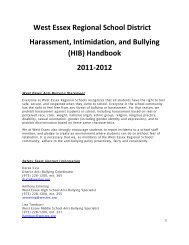Mathematics Department Math 7 Extended Course Syllabus 2012 ...
Mathematics Department Math 7 Extended Course Syllabus 2012 ...
Mathematics Department Math 7 Extended Course Syllabus 2012 ...
You also want an ePaper? Increase the reach of your titles
YUMPU automatically turns print PDFs into web optimized ePapers that Google loves.
<strong><strong>Math</strong>ematics</strong> <strong>Department</strong><strong>Math</strong> 7 <strong>Extended</strong><strong>Course</strong> <strong>Syllabus</strong><strong>2012</strong>‐2013Instructor: Sheryl Phillipse‐mail:sphillip@westex.orgPhone: 973‐228‐1200 X819A. Grading Policy – course work will be graded as follows:a. Summative Assessments (test, quizzes, projects) – 85% of gradeb. Formative Assessments (homework) – 15% of gradec. All grades should be verified in genesis on a regular basisB. Classrooma. Rules of Conducti. Follow all rules as stated in student handbookii. Come prepared to class with all required materialsiii. No food or drinks in classroomiv. No cell use without teacher consentb. Required Materiali. Textbookii. Pencilsiii. Graphing calculatoriv. Three ring binderc. Homeworki. All homework will be posted on the teacher’s school websiteii. Homework will not be accepted late unless the student hasbeen absent and/or has a medical excuseiii. As per math MS department policy any homework zero may bemade up for full credit provided it is done before the nextassessment, one per session, after school with meiv. Missed homework should be made‐up for understanding ofconceptsd. Aft er School Helpi. Available on Tuesday, Wednesday, Thursday afternoonsii. Will notify students if I cannot stay on a particular daye. Attendancei. Follow all rules as stated in student handbook
ii. One day to make up work for every day absentiii. Work assigned prior to absence(s) will be due on the first daybackf. Academic Integrityi. Students are to hand‐in their own work1. Receiving assistance is different from copyingii. Cheating will result in a zero on the assessment and a callhome to the parent<strong>Course</strong> Description:The Connected <strong><strong>Math</strong>ematics</strong> Program aims to expand student knowledge toprepare them for Algebra beyond symbolic manipulation and to offeropportunities for students to apply algebraic reasoning to problems in manydifferent contexts throughout the course of the curriculum. Eight units that focusformally on pre‐algebra instruction emphasize reasoning and communicationwhile constructing and reinforcing mathematical concepts through practice andapplication. The math 7 extended class is 62 minutes versus 42 minutes allowingstudents with less secure mathematics skills to cover the entire seventh gradecurriculum.A. Overarching Objective: Apply algebraic reasoning to problems in manydifferent contexts.a. Use variables and representations of relationships including tables,graphs, words, and symbols.i. Recognize problem situations in which two or morequantitative variables are related to each otherii. Identify quantitative variables in situationsiii. Describe patterns of change between two variables that areshown in words, tables and graphs of dataiv. Construct tables and graphs to display relations amongvariablesv. Observe relationships between two variables as shown in atable, graph, or equation and describe how the relationshipcan be seen in each of the other forms of representationvi. Use algebraic symbols to write equations relating variables
x. Write an equation to represent the pattern in a table ofrelated variablesxi. Apply proportional reasoning to solve for the unknown partwhen one part of two equal ratios is unknownxii. Set up and solve proportions that arise in applicationsxiii. Recognize that constant growth in a table is related toproportional situationsxiv. Connect unit rates with the equation describing a situationd. Recognize and represent linear relationships in tables, graphs, words,and symbols and solve linear equations.i. Recognize problem situations in which two or more variableshave a linear relationship to each otherii. Construct tables, graphs, and symbolic equations that expresslinear relationshipsiii. Translate information about linear relations given in a table, agraph, or an equation to one of the other formsiv. Understand the connections between linear equations andpatterns in the tables and graphs of those relations—rate ofchange, slope, and y‐interceptv. Solve linear equationsvi. Solve problems and make decisions about linear relationshipsusing information given in tables, graphs, and symbolicexpressionsvii. Use tables, graphs, and equations of linear relations to answerinteresting questionse. Calculate volume and surface area of various solidsi. Understand volume as a measure of filling an object andsurface area as a measure of wrapping or covering an objectii. Use flat patterns to visualize and calculate surface areas ofprisms and cylindersiii. Develop formulas for the volumes of prisms, cylinders, cones,pyramids, and spheres either directly or by comparison withknown volumesiv. Understand that three‐dimensional figures may have the samevolume but quite different shapes and surface areas or that
they may have the same surface area but different shapes andvolumesv. Use surface area and volume to solve a variety of real‐worldproblemsvi. Understand how changes in one or more dimensions of arectangular prism or cylinder affects the prism’s volumef. Describe variability, compare groups using measures of center anddistributions of equal and unequal sizesi. Apply the process of statistical investigation to pose questions,identify ways data are collected, determine strategies foranalyzing data and interpreting the analysis in order to answerthe questions posedii. Compare the distributions of data using their related centers,variability, and shapesiii. Use the shape of a distribution to estimate the mean andmedianiv. Recognize that variability occurs whenever data are collectedand use properties of distributions to describe the variability ina given data setv. Identify sources of variability, including natural variability andvariability that results from errors in measurementvi. Decide if a difference among data values and/or summarymeasures mattersvii. Understand and decide when to use the mean and median todescribe a distributionviii. Make effective use of a variety of representations to displaydistributions, including tables, value bar graphs, dot or lineplots, and bar graphsg. Calculate expected value and probabilities of two‐stage outcomesi. Interpret experimental and theoretical probabilities and therelationship between themii. Distinguish between equally likely and nonequally likelyoutcomesiii. Review strategies for identifying possible outcomes andanalyzing probabilities, such as using lists or counting treesiv. Understand that fairness implies equally likely outcomes
v. Analyze situations that involve two‐stages (or two actions)vi. Use area models to analyze situations that involve two stagesvii. Determine the expected value of a probability situationviii. Analyze binomial situationsix. Use probability and expected value to make decisionsB. Text( s)/resources/Software:a. Connected <strong>Math</strong> 2, Pearson Prentice Hall © 2006b. TI‐83/84 Plus calculatorc. SmartBoard and its Tools (<strong>Math</strong>, Notebook)d. TISmartView interactive software for TI‐84
















